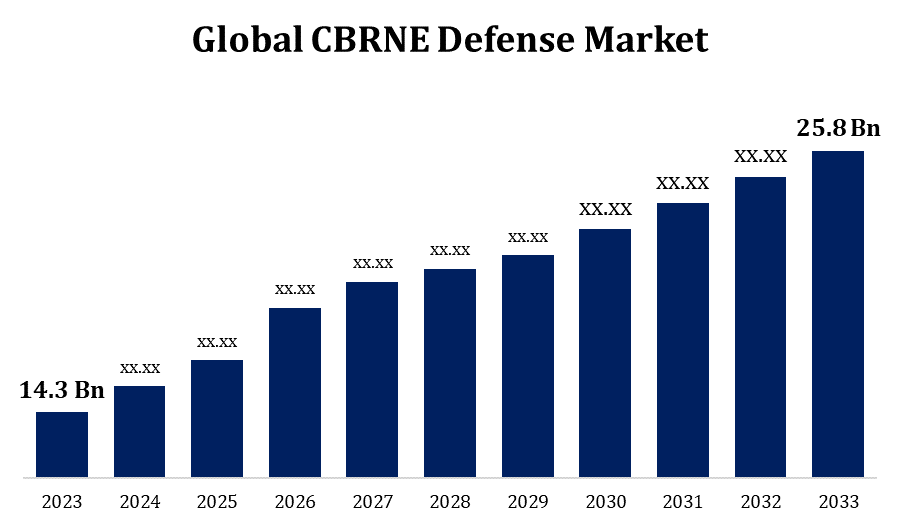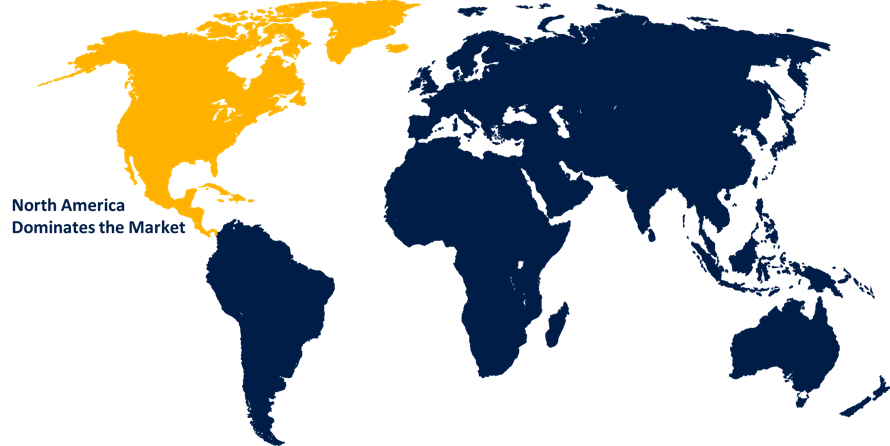Global CBRNE Defense Market Size To Worth USD 25.8 Billion By 2033 | CAGR of 6.08%
Category: Aerospace & DefenseGlobal CBRNE Defense Market Size To Worth USD 25.8 Billion By 2033
According to a research report published by Spherical Insights & Consulting, the Global CBRNE Defense Market Size to grow from USD 14.3 billion in 2023 to USD 25.8 billion by 2033, at a Compound Annual Growth Rate (CAGR) of 6.08% during the forecast period.

Get more details on this report -
Browse key industry insights spread across 200 pages with 120 Market data tables and figures & charts from the report on the "Global CBRNE Defense Market Size By Purpose (Detection, Protection, Decontamination, and Simulation & Training), By Application (Military and Civil and Law Enforcement), By Region, And Segment Forecasts, By Geographic Scope And Forecast to 2033." Get Detailed Report Description Here: https://www.sphericalinsights.com/reports/cbrne-defense-market
Over time, the global CBRNE defence business has steadily grown because to worries about terrorism, geopolitical turmoil, and the potential use of WMDs. The market's size is estimated differently depending on threat perception, geography, and defence budget; nonetheless, given the billions of dollars that are invested annually, the market is consistently enormous. Government defence funds are the primary source of funding for CBRNE defence capabilities, particularly in countries where security concerns are considerable. Military organisations allocate funds for training, research, and procurement linked to CBRNE defence; to remain competitive, these agencies often emphasise spending on state-of-the-art technologies.
CBRNE Defense Market Value Chain Analysis
Manufacturers produce a variety of subsystems and parts for CBRNE defence systems, including sensors, detectors, protective gear, decontamination tools, and communication devices. Because these parts are sometimes highly specialised, it may be necessary to use state-of-the-art materials, precision engineering, and rigorous testing to ensure their efficacy and reliability in demanding operating situations. Systems and platforms for CBRNE defence are assembled by integrators from disparate components and subsystems. CBRNE defensive systems undergo rigorous certification and testing processes to guarantee their dependability, efficiency, and compliance with user and regulatory requirements. Governments, armed forces, and other end users purchase CBRNE defence systems and equipment through direct contracts, open bidding, or foreign military sales.
CBRNE Defense Market Opportunity Analysis
Rapid developments in sensor technologies, artificial intelligence (AI), machine learning, and data analytics present opportunities to raise the sensitivity, accuracy, and speed of CBRNE threat detection and identification. It is becoming more and more important to have interoperable CBRNE defence systems that can readily exchange information and coordinate actions across multiple organisations and territories. Because CBRNE dangers are dynamic, personal protective equipment (PPE) like suits, masks, gloves, and footwear needs to be lightweight, breathable, and incredibly protective. Effective and timely cleaning methods are necessary to minimise the consequences of CBRNE occurrences and return affected areas to a safe state. As urbanisation increases and asymmetric threats proliferate, CBRNE security systems tailored to urban environments and unconventional adversaries become increasingly important.
Increased geopolitical tensions and regional conflicts increase the probability of CBRNE events. Concerns about the state-sponsored proliferation of CBRNE weapons, territorial disputes, and proxy conflicts—all of which exacerbate security issues—are what drive investments in CBRNE defence systems. Critical infrastructure is especially vulnerable to CBRNE threats in areas with high population densities and fast urbanisation. It becomes imperative to protect critical infrastructure from cyberattacks, such as government buildings, transit hubs, and utilities, which calls for comprehensive defence strategies. The combination of cyber and physical threats creates new challenges for CBRNE defence. The potential for cyberattacks that compromise situational awareness and response efficacy by targeting critical infrastructure, command and control systems, and CBRNE sensors is what drives investments in cyber-resilient CBRNE defensive solutions.
Timely and accurate detection and identification of CBRNE agents remains a formidable challenge. Extremely sensitive and selective detection devices that can distinguish between hazardous and safe substances are required since many CBRNE agents have low concentrations and can be concealed or masked. Decontaminating persons, property, and the surrounding area after a CBRNE incident is a challenging and resource-intensive process. Although quick, thorough, and environmentally safe decontamination methods are crucial, they present operational and logistical challenges in contaminated areas. CBRNE defensive systems are vulnerable to internet threats including malware, hacking, and denial-of-service attacks since they rely more and more on digital technology.
Insights by Purpose
The detection segment accounted for the largest market share over the forecast period 2023 to 2033. The proliferation of CBRNE materials and the growth of state and non-state actors who have access to these agents raise the likelihood of CBRNE accidents. As a result, there is an increasing need for advanced detection systems to identify and locate CBRNE hazards in various contexts. Protecting critical infrastructure, such as transportation networks, energy facilities, and government buildings, against CBRNE threats is of utmost importance to governments and security organisations. Installing CBRNE detection systems at key infrastructure locations enhances security procedures and makes it easier to quickly identify and eliminate potential threats. Protecting critical infrastructure, such as transportation networks, energy facilities, and government buildings, against CBRNE threats is of utmost importance to governments and security organisations.
Insights by Application
The military segment accounted for the largest market share over the forecast period 2023 to 2033. Military personnel have to deal with ever-changing CBRNE threats from terrorist organisations and rogue states, among other state and non-state actors. The proliferation of CBRNE materials and the potential for WMD deployment in conflict scenarios make strong CBRNE defence capabilities very desirable inside military organisations. When it comes to military operations like fighting, peacekeeping, and humanitarian relief missions, CBRNE threats are often prevalent. Military forces require particular equipment and training in order to identify, prevent, and respond to CBRNE incidents in a range of operating circumstances, including urban areas, combat zones, and disaster areas. Military personnel require specialised protective clothing and equipment in order to lessen the impact of CBRNE threats while on missions.
Insights by Region

Get more details on this report -
North America is anticipated to dominate the CBRNE Defense Market from 2023 to 2033. Threats to the security of North America are numerous and include terrorism, asymmetric warfare, and geopolitical problems. Fears of CBRNE material spreading and potential WMD use by state and non-state actors have made strong CBRNE defensive capabilities highly desirable. Protecting critical infrastructure in North America from CBRNE threats is critical. Government structures, energy facilities, and transportation networks are all included in this. Investing in CBRNE detection, surveillance, and response capabilities aims to minimise the impact of potential attacks and safeguard important assets from harm. Improving response and readiness for homeland security is a major priority in North America.
Asia Pacific is witnessing the fastest market growth between 2023 to 2033. Terrorism, territorial disputes, and regional conflicts are among the threats to regional security in the Asia-Pacific region. Fears of CBRNE material spreading and potential WMD use by state and non-state actors have made strong CBRNE defensive capabilities highly desirable. Industry participants in the Asia-Pacific CBRNE defence market include both domestic and international companies. Certain countries have their own CBRNE defence capabilities, but others rely on imports and partnerships with foreign suppliers. A few countries in the Asia-Pacific region export materials and technologies related to counterterrorism. The growing need for CBRNE defence solutions in emerging nations is an opportunity for Asia-Pacific suppliers and manufacturers to expand their global reach.
Recent Market Developments
- In March 2023, Bruker Corporation has delivered significant bioinformatics advancements for 4D-Proteomics with its timsTOF technology. This involves developing a novel de novo sequencing method in collaboration with Rapid Novor Inc.
Major players in the market
- Thales Group
- Smiths Group plc
- Mine Safety Appliances
- Karcher Futuretech GmbH
- Bertin Technologies
- Argon Electronics
- Battelle Memorial Institute
- Blücher
- Nexter Group KNDS
- Chemring Group PLC
- Teledyne FLIR LLC
- Avon Protection
- Bruker Corporation
- Cristanini S.p.a
- Leidos
Market Segmentation
This study forecasts revenue at global, regional, and country levels from 2023 to 2033.
CBRNE Defense Market, Purpose Analysis
- Detection
- Protection
- Decontamination
- Simulation & Training
CBRNE Defense Market, Application Analysis
- Military
- Civil and Law Enforcement
CBRNE Defense Market, Regional Analysis
- North America
- US
- Canada
- Mexico
- Europe
- Germany
- Uk
- France
- Italy
- Spain
- Russia
- Rest of Europe
- Asia Pacific
- China
- Japan
- India
- South Korea
- Australia
- Rest of Asia Pacific
- South America
- Brazil
- Argentina
- Rest of South America
- Middle East & Africa
- UAE
- Saudi Arabia
- Qatar
- South Africa
- Rest of Middle East & Africa
About the Spherical Insights & Consulting
Spherical Insights & Consulting is a market research and consulting firm which provides actionable market research study, quantitative forecasting and trends analysis provides forward-looking insight especially designed for decision makers and aids ROI.
Which is catering to different industry such as financial sectors, industrial sectors, government organizations, universities, non-profits and corporations. The company's mission is to work with businesses to achieve business objectives and maintain strategic improvements.
CONTACT US:
For More Information on Your Target Market, Please Contact Us Below:
Phone: +1 303 800 4326 (the U.S.)
Phone: +91 90289 24100 (APAC)
Email: inquiry@sphericalinsights.com, sales@sphericalinsights.com
Contact Us: https://www.sphericalinsights.com/contact-us
Need help to buy this report?